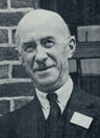THE BRITISH OBJECT RELATIONS SCHOOL: W. R. D. FAIRBAIRN
We only become what we are by the radical and deep-seated refusal of that which others have made of us.
-- Jean-Paul Sartre
For Freud, in short, man was the ambivalent animal; for Winnicott, he would be the dependent animal. . . . Prior to sexuality as the unacceptable, there was helplessness. Dependence was the first thing, before good and evil.
-- Adam Phillips
Human beings, in Freud's account, are born at odds with their environment. They are wired the way Freud and his contemporaries understood animals to be, oriented toward pursuing simple pleasures with ruthless abandon. But in Freud's Hobbesian view of human society, the individual's pursuit of egoistic satisfactions endangers other individuals, necessitating a control by the group on the hedonic aims of each individual. The project of childhood is socialization, the transforma-
tion of the infant, with his or her bestial impulses, into the adult, with his or her complex psychic apparatus and its intricate and elaborate system of checks and barriers channeling those impulses and aims into socially acceptable forms of civilized living.All the important contemporary psychoanalytic schools view the human infant as less alien, more suited and adapted to the world into which he or she is born, than Freud did. As we have seen in chapter 2, Heinz Hartmann's concept of adaptation provided the central conceptual vehicle for the transition from Freud to contemporary Freudian ego psychology. It was Melanie Klein who provided the crucial bridge between Freud and modern British object relations theories.
In redefining the nature of "drive" to include built-in human objects, Klein fundamentally altered the basic premises and metaphors underlying psychoanalytic theorizing. Freud envisioned a developmental passage from animal to person. Klein portrayed a distinctly human infant from the start, an infant who does not learn about the breast through "accidental" association, but who instinctively knows about the breast because she is born with that knowledge. Just as the infant's mouth is anatomically shaped to fit the mother's nipple, the infant's instinctual impulses are shaped to fit the distinctively human world into which she is born.
Yet Klein's baby is not a very happy baby. This baby is born with the capacity to organize discomfort and pain into an image of a persecutory, "bad" Other, and to organize comfort and pleasure and pain into an image of a rescuing, "good" Other. Because early experiences collect around prewiredobjects, constitutional patterns of danger and refuge, that infancy is inevitably fragmented and terrifying. For Klein, the project of childhood is not socialization, but amelioration of the frightening, nightmarish conditions of the infant's experience of being in the world which derive from the intensity of the infant's needs and the overwhelming force of constitutional aggression. We are born with psychotic anxieties and, under favorable conditions, sanity becomes a developmental achievement. Although pre-wired to draw her into the human environment, the infant's instincts, in Klein's account, generate inevitable and considerable psychic pain, which, under favorable circumstances, can be contained, organized and assuaged by good parenting.
In the early 1940s, after decades of acrimonious debate, the British Psychoanalytic Society split into three groups: those who fully accepted Melanie Klein's innovations in theory and technique; those who remained loyal to more traditional Freudian concepts and practice (headed by Anna Freud and extended into Freudian ego psychology); and an "independent" or middle group, who developed non-Kleinian versions of what came to be known as object relations theories. The major figures in this middle group, W. R. D. Fairbairn, D. W. Winnicott, Michael Balint, John Bowlby, and Harry Guntrip, all built on Klein's vision of an infant wired for human interaction. Yet they also all broke with Klein's premise of constitutional aggression deriving from the death instinct, proposing instead an infant wired for harmonious interaction and nontraumatic development but thwarted by inadequate parenting.
In recalling his early days in the British Psychoanalytic Society, when the Kleinian belief in the aggressive, destructive baby predominated, John Bowlby cited as a milestone in the emergence of his own independent line of thought the moment when he rose defiantly to assert, in the middle of
one such discussion, "But there is such a thing as a bad mother." That succinct statement might serve as banner heralding in the development of postKleinian British object relations theories.1W. R. D. FAIRBAIRN
Freud's clinical observations charted the vicissitudes of human misery, the ways people systematically make themselves unhappy over and over again: thesymptom neurosis, in which compulsive, bizarre behavior intrudes into experience; the character neurosis, in which maladaptive, self-defeating patterns of behavior compromise interactions with others; thefate neurosis, in which the same self-destructive destiny is orchestrated repeatedly;depression, in which emotional pain is perpetually regenerated. Yet Freud's broad motivational theory, anchored in his concepts of instinctual drive and the pleasure principle, is a hedonic theory: People seek pleasure and avoid pain. The motivational framework of drive theory is very difficult to reconcile with Freud's clinical observations of therepetition compulsion, the systematic regeneration of distress: painful symptoms, painful patterns of behavior, painful fates, painful affective states. If people are meant to seek pleasure and avoid pain, why are most of us so extraordinarily competent at keeping ourselves unhappy?
According to the pleasure principle, libido is malleable, employing a variety of interchangeable objects in its pursuit of pleasure; it ought to be able to discard painful desires and frustrating objects. Yet, Freud noted in 1905, the libido also has a property he termed adhesiveness, which seems to operate at odds with the pleasure principle. Libido gets painfully stuck to old, inaccessible objects, frustrated longings, thwarted desires. The Oedipus complex, the heart of Freud's clinical theory, is the prime example of this. Freud returned to this knotty problem again and again, in his efforts to explain nightmares (since he understood dreams as wish fulfillments), sexual masochism (since he understood sexuality as the pursuit of pleasure, not pain), traumatic neurosis (in which terrifying experiences are impossible to leave behind).2www.psychspace.com心理学空间网

